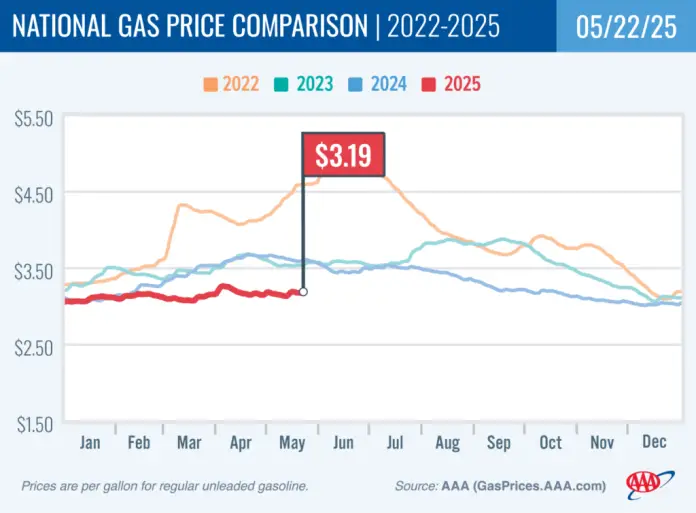As Memorial Day approaches, small business owners can breathe a sigh of relief, at least when it comes to fuel costs. The latest report from the American Automobile Association (AAA) indicates that the national average price for a gallon of regular gasoline has remained steady this week at $3.19. This stability comes as many prepare for a long holiday weekend, with a record number of drivers expected to hit the roads.
Gas prices this year are particularly noteworthy. According to AAA, prices are the most stable they’ve been in years, reflecting an average just below $3.20—significantly lower than last year’s $3.61. Since gas prices play a crucial role in the operating costs of small businesses, especially those reliant on transportation, any relief at the pump can have a positive ripple effect on their bottom line.
Despite a slight dip in gasoline demand—from 8.79 million barrels per day (b/d) last week to 8.64 million b/d this week—overall domestic gasoline supply has increased. The Energy Information Administration (EIA) reports that gasoline production is averaging 9.6 million b/d, which has contributed to the current price stability. Increased supply coupled with reduced demand is a formula small businesses can leverage for better budgeting and forecasting.
The EIA also highlights that crude oil inventories rose by 1.3 million barrels last week, bringing the total to 443.2 million barrels. Altogether, U.S. crude oil inventories stand about 6% below the five-year average for this time of year, indicating a balanced market.
While gas prices remain manageable, small business owners might want to consider the geographical factors affecting their operations. For example, gas prices vary significantly across states, with California topping the list at $4.87 per gallon, while Mississippi boasts the lowest at $2.66. This disparity can affect logistics and pricing strategies, especially for businesses operating in multiple states or relying heavily on transportation services.
For businesses exploring the transition to electric vehicles (EVs), electricity prices at public charging stations also remain stable at an average of 36 cents per kilowatt hour. While this presents a relatively low entry cost for electrifying a fleet, businesses should weigh the potential savings against the initial investments in EV technology and infrastructure.
Small businesses looking to stay informed about fuel costs can use the AAA TripTik Travel Planner, which offers real-time gas and electric charging price data along travel routes. This tool can assist in planning more efficient routes and managing fuel budgets, a crucial aspect for businesses aiming to maximize profitability amid fluctuating costs.
In light of these developments, small business owners can approach the busy holiday weekend with a clearer understanding of their fuel expenditures. With prices holding steady, businesses may find opportunities for cost savings, enhanced planning, and improved cash flow.
As the long weekend approaches, understanding these dynamics can make a difference. The market’s current stability provides a moment of reprieve, but it also brings into focus the importance of proactive planning in managing fuel costs efficiently. Small business owners should remain vigilant, as even small fluctuations can have significant implications for their operations.
To learn more about the current gas and electricity pricing landscape, visit the AAA website.
Image Via Gas Price



